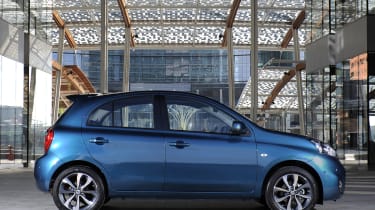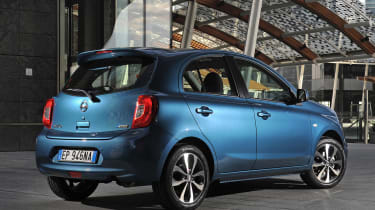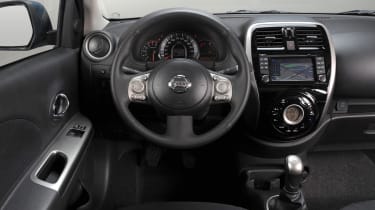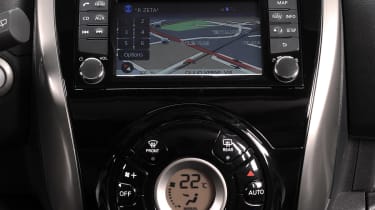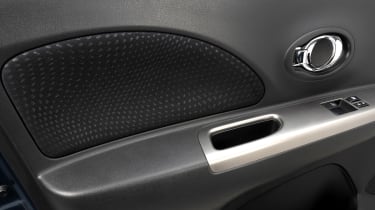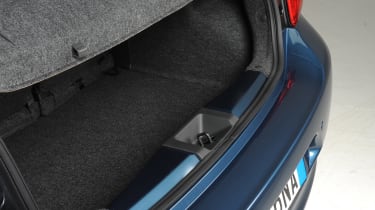Nissan Micra review (2010-2016)
The fourth-generation Nissan Micra supermini offers more space than before, as well as lower emissions and better economy

The Nissan Micra has been around for three decades, rivalling long-running best-sellers like the Ford Fiesta, Vauxhall Corsa and Renault Clio. One model even reached the heady heights of car of the year back in 1993, so the Micra comes from strong pedigree - and it's won fans thanks to its incredible reliability and easy driving experience.
The latest model was released in 2011, and has since benefited from a facelift in 2013. It’s only available as a five-door hatchback, and where previous models featured bold design and top-notch quality, the latest version has been built as a low-cost ‘world car’, enabling Nissan to assemble and sell it in emerging markets. In fact, the Micra is said to be available in 160 different countries around the world.
The car sits on Nissan’s V Platform, which is a development of the Nissan-Renault B Platform that underpinned the previous-generation Micra, as well as various Renault models like the Clio, Modus and Twingo.
While previous generations have been built in Japan, and from 1992 at Nissan’s Sunderland plant in the UK, since 2010 all European market Micras have been imported from the Nissan factory in Chennai, India. At home in India, buyers can choose a Renault-badged version of the Micra called the Pulse.
Here in the UK, Nissan Micra buyers can choose from four trim levels: Visia (and the entry-level Visia Limited Edition model), Acenta, n-tec and Tekna. All versions get a Bluetooth phone connection, electric front windows, remote central locking and a trip computer.
Used - available now

2023 MINI
Cooper Electric
22,248 milesAutomaticElectric
Cash £12,687
2021 Nissan
Leaf
17,471 milesAutomaticElectric
Cash £11,387
2022 Citroen
e-C4
27,861 milesAutomaticElectric
Cash £12,987
2020 Ford
Focus
17,904 milesManualPetrol1.0L
Cash £14,400Acenta trim adds cruise control, automatic lights and wipers, alloy wheels and a leather steering wheel; n-tec brings the NissanConnect infotainment set-up with navigation, plus parking sensors and a six-speaker audio system. Meanwhile, the most expensive Tekna features keyless entry and suede-effect trim.
The only engine on offer is a 1.2-litre petrol three-cylinder, but it’s available in naturally aspirated and supercharged guises. Both are hooked up to a slick five-speed manual gearbox as standard, while a CVT automatic transmission can be specified as an optional extra.
The latest version of the Nissan Micra supermini is sold only as a five-door, and provides plenty of room as well as a decent 265-litre boot. The car is reasonably well equipped, too. It's just let down by a rather low-rent finish inside, while the exterior styling is a bit awkward, too.
Light controls and good visibility ensure the Micra is a doddle to drive around town, plus it's easy to park. However, a choppy ride and poor refinement combine to make the car far from relaxing on long journeys. With its lifeless steering, low levels of grip and average body control, the Nissan can't match models such as the Ford Fiesta or Mazda 2 for driving fun, either.
Engines, performance and drive
The supermini market is fiercely competitive, and unfortunately in various areas more proficient rivals expose weaknesses in the Nissan Micra package.
At higher speeds, the suspension doesn’t seem up to the job of dealing with rough roads, and it feels crashy and a little unsettled. The engine makes a racket in the cabin and there’s a lot of wind and road noise, which mean long journeys may be tiresome even on well surfaced motorways.
The Micra feels a little out of its depth through a series of corners, too. The light steering lacks feedback, there’s plenty of body roll and the car can’t match rivals such as the Ford Fiesta for grip.
Still, it’s safe and predictable, while the high-set driving position and excellent visibility make it easy to place on the road.
And in spite of its flaws, the Nissan Micra still makes a great city runabout as a result of its good visibility, light steering and responsive controls. It also benefits from a tight turning circle, meaning navigating busy urban areas is a breeze.
Engines
The 1.2-litre three-cylinder petrol engines powering the Nissan Micra won't amaze you with their performance. In many respects, the lower-powered version – the 79bhp naturally aspirated unit – is the better bet, as it’s cheaper to buy yet doesn’t feel much less sprightly than the 97bhp supercharged DiG-S model.
The figures suggest the difference ought to be a bit more noticeable, as the basic version claims 0-62mph in 13.7 seconds with a top speed of 106mph, while the DiG-S is quoted at 11.3 seconds and 112mph.
If you go for the DiG-S with the CVT automatic instead of a manual gearbox, those figures drop to 11.9 seconds and 109mph – or 14.5 seconds and 100mph with the lower-powered engine. In either case, be prepared for the CVT’s persistently unpleasant drone under acceleration.
There’s no diesel option, as Nissan considers the Micra to be efficient enough without it.
MPG, CO2 and Running Costs
As with most superminis, the Nissan Micra is cheap to run. While it doesn't come with a diesel engine, the petrol options are efficient and promise reasonably low CO2 emissions.
For instance, the standard three-cylinder 79bhp 1.2-litre petrol engine claims fuel economy of 56.5mpg and 115g/km of CO2. It’s a good choice as it also feels nippy and responsive, even on the open road. However, those emissions place this version in VED band C, which means owners will pay £30 a year for road tax.
Buyers seeking a better blend of performance and economy should opt for the slightly more powerful 97bhp DIG-S supercharged engine. This is equipped with stop/start, and improves the Nissan Micra both in terms of efficiency and power. In Visia guise it claims 68.9mpg and 95g/km CO2 emissions. The heavier Acenta and Tekna versions claim 65.7mpg and 99g/km, but all three qualify for free road tax.
It’s not entirely good news, though, as you’ll pay between around £1,100 and up to nearly £2,000 extra for a Micra powered by the more efficient engine, depending on trim level.
Models equipped with the CVT box are the least efficient, as well as the most expensive to buy – the auto option adds around £1,000 to the price. The lower-powered engine with the CVT claims 52mpg economy and 125g/km emissions, so will cost £105 per year with band D road tax. The DiG-S promises 57mpg and 115g/km with the CVT, meaning £30-a-year band C road tax.
Insurance groups
Nissan Micra insurance groups range from five to nine, so annual premiums aren’t going to break the bank. While the Ford Fiesta kicks off at insurance group three, it quickly rises with greater performance up to group 18; the Vauxhall Corsa line-up starts in insurance group two.
Depreciation
It’s clearly been built down to a price, so the latest Micra hasn’t been a showroom star for Nissan, and it’s not one of the most desirable second-hand buys, either. While that’s great news for drivers looking for cheap and cheerful runabouts down the line, it means anyone buying new is likely to see the value tumble – especially compared to, say, a supermini from the VW Group stable, such as the Volkswagen Polo or Skoda Fabia. If you want to minimise your depreciation losses, stick to the more basic versions of the Nissan Micra.
Interior, design and technology
The latest-generation Nissan Micra lost the distinctive looks of its predecessor, but the design was supposed to appeal to a wider audience. Even so, the company updated the car in 2013, adding all-new front wings, and tweaking the bonnet, headlights and the rear bumper to help create a cleaner look that’s more in line with the brand’s latest family design themes.
The Micra is available in four trim levels: Visia, Acenta, n-tec and Tekna. Visia spec is fairly basic, and it does without kit such as alloy wheels and front foglamps. Air-conditioning costs an extra £500, unless you opt for the supercharged DiG-S engine, in which case it’s standard. Still, the Visia model does get body-coloured bumpers, USB connectivity, a Bluetooth phone connection, electric front windows and stability control.
The mid-range Acenta is our favourite version of the Nissan Micra, as it comes with 15-inch alloy wheels and body-coloured door handles and mirrors, as well as chrome finishes in the interior. There are also more safety features and automatic headlamps.
Top Tekna spec adds parking sensors, keyless entry, unique alloy wheels and a roof-mounted spoiler. The flagship, as well as the n-tec models, also features a touchscreen sat-nav, plus Google technology that allows you to use your phone and access your music library.
Yet despite this big car kit, the Micra appears a little low-rent inside. There’s nothing wrong with the robust fit and finish, but the materials used throughout look and feel cheap. Some of the trim even has sharp edges left over from the moulding process – the glovebox lid and the internal door handles are among the worst offenders here.
Sat-nav, stereo and infotainment
Micra n-tec and Tekna models feature the NissanConnect touchscreen navigation and entertainment system as standard. They also get DAB digital radio, Bluetooth connectivity and an upgraded six-speaker stereo including steering wheel controls. The latter is available as an option on Acenta models, too.
NissanConnect allows you to Google your route on a PC or smartphone and send it to the car – where it’s displayed on the 5.8-inch touchscreen – plus it provides access to lots of Google search information en route.
Practicality, comfort and boot space
The Nissan Micra is only sold in a five-door, five-seat hatchback configuration, and thanks to its wheel-at-each-corner design, it’s actually quite roomy for such a small car.
There’s a reasonable amount of space in the driving seat, although to benefit from height adjustment you need Acenta trim or above. The steering wheel has a standard tilt function, but sadly it’s not adjustable for reach.
Thanks to a large glass area and narrow windscreen pillars, the Micra offers great all-round visibility. There is also plenty of storage space in the cabin, including a huge, double-decker glovebox, decent-sized door bins and a couple of cup-holders.
Size
This decent packaging is all the more impressive as the Nissan Micra isn’t one of the biggest superminis on the market. At 3,780mm long, it’s shorter than the 4,035mm Hyundai i20 and the 3,992mm Volkswagen Polo, while it’s 6cm narrower than both these cars, too. However, the Micra does have a height advantage: at 1,520mm, it’s taller than the 1,474mm Hyundai and 1,467mmm Volkswagen.
Leg room, head room & passenger space
There's enough room for relatively tall adults to sit in the back of the Micra, but despite the fact Nissan provides three seatbelts, you probably wouldn’t want to spend too long packed in with two other adults. It’s a different story for children, of course – and either way, access to the rear is good through wide-opening back doors, while Isofix child seat mounting points are standard in the rear.
Boot
The Nissan Micra has 265 litres of boot space, which is around what you'd expect from a supermini. You can fold down the rear seats to increase the luggage capacity to a maximum of 1,132 litres, although only mid-range Acenta and top-spec Tekna versions come with split-folding back seats – entry-level models have to make do with a single-piece bench.
Having said that, the entry-level Nissan Micra Visia still has a bigger boot than the likes of the Suzuki Swift.
Reliability and Safety
In the Auto Express Driver Power 2015 satisfaction survey, the Nissan Micra didn't feature in the top 200 cars. This is a surprise, because as recently as in Driver Power 2013, the supermini finished in a respectable 24th place – a result that can be largely attributed to the car’s reliability and low running costs. Back then, owners also praised the Micra’s technology.
Fast forward to Driver Power 2015 again, and Nissan finished a poor 28th out of 32 brands in the manufacturers' chart – down six places from its 2014 result. And in 2013, the company had ranked a superb 12th, so our Driver Power respondents are certainly pointing towards a downward trend.
Back to 2015, and as a brand Nissan didn’t fare quite so badly for reliability – although its weak rating of 21st out of 32 in this category is probably still a little at odds with most people’s perceptions. The company’s worst result was for build quality, where it scraped in at 29th out of 32, beating only Alfa Romeo, Suzuki and Chrysler.
The Nissan Micra also achieved a disappointing four-star rating in the Euro NCAP crash test. This is a severe disadvantage in a class and an industry where the maximum five-star ratings are becoming the norm.
Even so, all versions of the Micra get six airbags, anti-lock brakes and electronic stability control as standard. The fundamentals are in place, then; what’s missing is the option to specify the brand’s award-winning Safety Shield kit. This can be added to models such as the Nissan Note and Qashqai, and includes low-speed collision avoidance and blind spot monitoring.
Warranty
All Nissans come with a three-year/60,000-mile warranty, which is about average for this class. If you want more cover, it’s worth remembering that the Hyundai i20 is supplied with a five-year/unlimited mileage warranty, while the Kia Rio has a seven-year package, although it’s limited to 100,000 miles.
Servicing
Fixed-price services start at £149 for the Micra, and if you sign up to this scheme, Nissan will throw in free European roadside assistance, which it reckons is a £95 saving.
